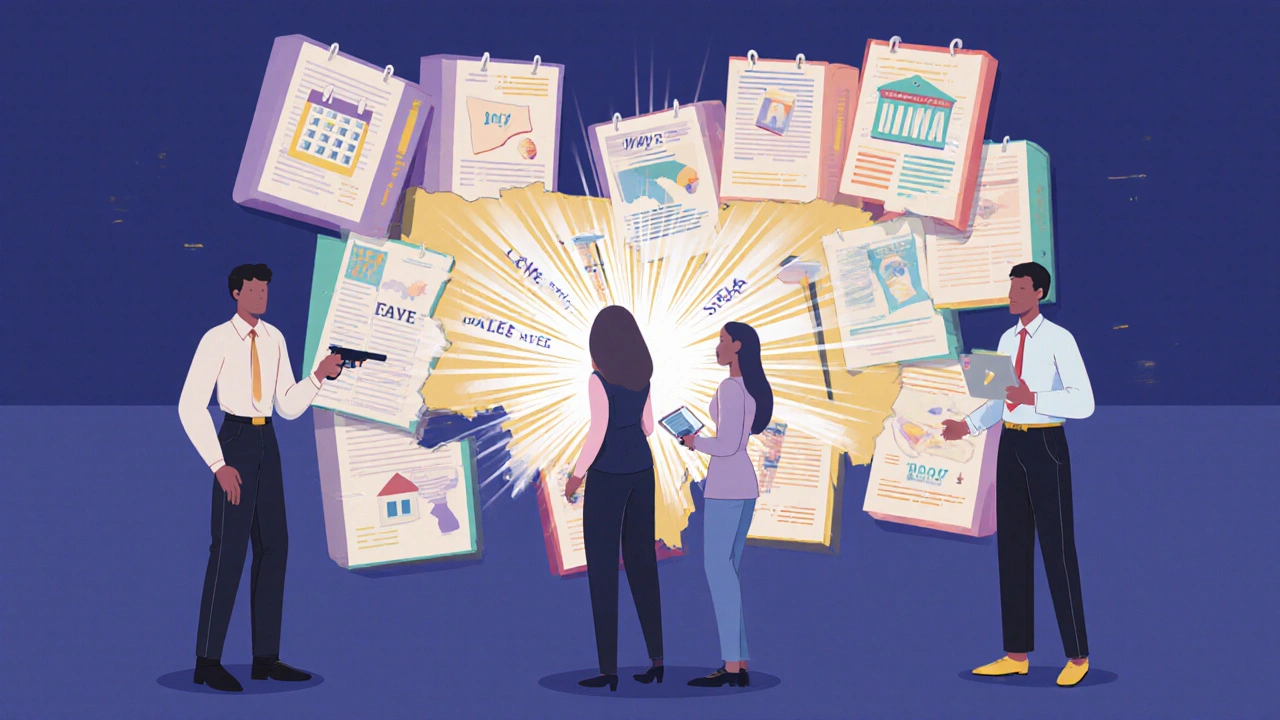By November 2025, the legal landscape in the U.S. has shifted more dramatically than in any year since 2010. It’s not just about new laws-it’s about how those laws change what businesses, workers, and families can do every day. From pay transparency rules to gun rights, from tax deductions to housing permits, the rules are rewriting themselves faster than most organizations can keep up.
What’s Actually Changing in 2025-2026?
You can’t just wait for a memo from HR or your lawyer. The changes are happening now, and they’re not all big headlines. Some are quiet but powerful. Take California’s Assembly Bill 406. It didn’t make national news, but it merged three separate leave laws into one. Now, if you’re a victim of domestic violence or you’re caring for a family member who is, you get paid time off under the same rules as sick leave. And it’s not just California. Thirty-seven states passed at least one new employment law in 2025. That’s nearly every state. If you run a business with employees in more than one state, you’re managing 37 different rulebooks.
At the federal level, the One, Big, Beautiful Bill (Public Law 119-21) changed how millions of Americans file taxes. Starting in 2025, people over 65 get a $6,000 deduction-no itemizing needed. That’s real money. But it came with a twist: the IRS went back to the old $20,000 reporting threshold for Form 1099-K. That means if you’re a freelancer or gig worker, you won’t get a 1099 unless you made over $20,000 and had more than 200 transactions. For many, that’s a relief. For others, it’s a headache because they thought the lower $600 rule was permanent.
California’s Housing Law Revolution
California didn’t just tweak housing rules. It tore down the old system. Assembly Bill 130 and Senate Bill 131, passed as part of the 2025 state budget, removed major barriers under the California Environmental Quality Act (CEQA). For years, developers had to go through years of reviews just to build apartments near transit hubs or in dense urban areas. Now, if a project meets certain affordability and density targets, it skips most of that review. The California Building Industry Association says this could cut approval times by 18 to 24 months. That’s not a small win-it’s a game-changer for housing supply.
But it’s not just about speed. The law forces cities to be more accountable. If they don’t approve housing projects that meet the criteria, they lose state funding for roads and water systems. That’s a powerful incentive. Economists estimate this could boost annual housing production by 15% to 20% over the next five years. For renters, that means more options. For builders, it means fewer delays. For local governments, it means harder choices.
Gun Rights Expand-But Only for Some
The LEOSA Reform Act of 2025 (H.R.2243) didn’t make headlines like the Roe v. Wade reversal did, but it quietly changed how thousands of retired police officers live. Before this law, retired officers could carry concealed firearms in most places-but not in school zones, national parks, or on private property open to the public. Now they can. The law also lets states lower the frequency of firearms qualification tests for retired officers. Some states used to require annual retraining. Now, they can extend it to every three years.
This isn’t about expanding gun rights for everyone. It’s about recognizing the unique status of trained law enforcement personnel-even after retirement. The law passed the House 285-136, with bipartisan support. But it’s still stalled in the Senate. If it becomes law, it will affect over 200,000 retired officers nationwide. For them, it’s not a political statement. It’s about safety, identity, and consistency across state lines.

Supreme Court’s Next Big Moves
The Roberts Court turns 20 in 2025. And it’s not resting. Legal analysts expect landmark rulings on presidential power, voting rights, and federal agency authority. One pending case could redefine how much control the president has over independent agencies like the FTC or the SEC. Another could limit how courts interpret vague laws passed by Congress. That’s called the “major questions doctrine,” and if it expands, it could gut decades of federal regulation.
Think about it: if the Supreme Court says the EPA can’t regulate carbon emissions unless Congress explicitly says so, then climate policy gets stuck. Same with labor rules, healthcare mandates, or financial oversight. The court isn’t making new laws-it’s deciding who gets to make them. And that shift could ripple through every industry, from energy to tech to healthcare.
What Businesses Must Do Now
You can’t hire more lawyers and call it a day. Compliance isn’t a department anymore-it’s a company-wide muscle. Companies are spending 15% to 20% more on compliance staff. Some are hiring dedicated regulatory analysts. Others are buying AI tools that scan new laws and flag changes in real time. Deloitte found that 78% of Fortune 500 companies plan to use AI-powered regulatory monitoring by 2026. That’s not science fiction. It’s survival.
California employers are spending $1,200 to $1,800 per employee on training just for AB 406. That’s not optional. If you don’t update your HR systems, you risk lawsuits. The Civil Rights Department already released a new model notice for victims’ leave. If you’re not using it, you’re behind.
And don’t forget taxes. The IRS released five new guidance documents in October 2025 alone. If you’re a small business owner using platforms like Uber, Etsy, or DoorDash, you need to know whether you’ll get a 1099-K this year. If you’re claiming the Employee Retention Credit, you need to know the rules changed under the One, Big, Beautiful Bill. There’s no grace period. The IRS doesn’t wait.

Why This Matters for Everyone
These aren’t just laws for lawyers or CEOs. They affect your paycheck, your housing costs, your right to carry a gun, your ability to take time off after a family tragedy. They change whether your elderly parent gets a tax break or whether your teenager can find an apartment near their college.
The biggest myth is that federal deregulation means less work. It doesn’t. When the feds pull back on Medicare Advantage rules or anti-money laundering checks, states rush in to fill the gap. So now you have to follow federal rules and state rules-and they often contradict each other. A bank in Texas might have looser AML rules than one in New York. A nurse in Florida might have different leave rights than one in Oregon.
This isn’t chaos. It’s complexity. And complexity is expensive. PwC estimates companies that don’t adapt will see compliance costs rise by 15% to 25% over the next two years. That’s not a budget line. That’s lost revenue, delayed projects, and missed opportunities.
The Tools Are Here-Are You Using Them?
You don’t need to be a lawyer to keep up. There are free resources: the IRS website, state labor department portals, RegEd’s public tracker. Some nonprofits offer updated compliance checklists. Legal tech companies like LexisNexis and Thomson Reuters now have free tiers for small businesses.
But the real shift is in mindset. You can’t wait for a law to be passed before you act. You need to monitor. You need to assign someone-yes, even if you’re a solo entrepreneur-to track changes. You need to ask: “How does this affect my daily operations?” Not “Is this legal?” but “What do I need to change tomorrow?”
The future of law isn’t about more rules. It’s about faster adaptation. The winners won’t be the ones with the biggest legal teams. They’ll be the ones who move fastest.
Are the new California labor laws only for big companies?
No. California’s labor laws, including AB 406 and SB 642, apply to all employers with five or more employees. Even if you have just one worker in California, you must comply. Small businesses aren’t exempt. The state enforces these rules equally, and penalties start at $100 per violation per employee.
Will the $6,000 tax deduction for seniors affect my Social Security benefits?
No. The $6,000 deduction under the One, Big, Beautiful Bill is a tax deduction, not a benefit. It reduces your taxable income, but it doesn’t count as income for Social Security calculations. That means your benefits won’t be reduced or taxed more because of it. The IRS confirmed this in FS-2025-07.
What happens if my business operates in multiple states?
You must comply with the strictest rule in each category. For example, if one state requires 12 weeks of paid family leave and another requires 8, you must offer 12 weeks to employees in both states if you’re covered by both laws. Many companies use a “highest standard” approach to avoid violations. Tools like RegEd and Paycom now automate this by mapping employee locations to applicable laws.
Can I still carry a concealed gun if I’m a retired officer in a state that doesn’t allow it?
Under the proposed LEOSA Reform Act, yes-if it passes. The law would override state bans on concealed carry for qualified retired officers in public places like parks, schools, and government buildings. But if the bill fails, current state laws still apply. Some states, like New York and California, have very strict rules that remain in place unless federal law overrides them.
How do I know if a new law affects me?
Start with your state’s official government website-look for the legislative or labor department page. Then check the IRS website for tax changes. Use free tools like RegEd’s public tracker or the National Conference of State Legislatures (NCSL) database. If you’re in a regulated industry (healthcare, finance, housing), join your industry association-they send out alerts. Don’t rely on news headlines. They often miss the details.
Is AI really necessary for compliance?
It’s not mandatory, but it’s becoming essential. Manual tracking of 4,800+ regulations across 50 states is impossible without software. AI tools scan new bills, compare them to your operations, and flag conflicts. They don’t replace lawyers-they help you act before you get sued. For small businesses, many platforms now offer subscription plans under $100/month.


Comments (12)
California’s new leave law is a no-brainer. If you’re dealing with trauma, you shouldn’t have to fight for time off.
Simple. Necessary. Done.
People are acting like the 1099-K threshold change is some massive win. It’s not. It’s just the IRS admitting they screwed up in 2022 and are now backpedaling. The real issue? No one’s talking about how this creates a black hole for gig workers under $20K who still need to track income for state taxes. You think the IRS cares if you’re confused? They don’t.
And don’t get me started on the ‘One Big Beautiful Bill’ name. That’s PR fluff for a tax code that’s still a dumpster fire.
For those wondering about cross-state compliance: the ‘highest standard’ approach is not just wise-it’s legally defensible. Many companies mistakenly assume they only need to comply with the law of the state where the employee is physically located. That’s incorrect. If an employee works remotely from California but is hired through a Texas office, California law still applies to them.
Additionally, the IRS’s $20,000 1099-K threshold applies to payment settlement entities, not individual platforms. So if you use both Uber and Etsy, your totals are aggregated. You can’t split income across platforms to avoid reporting.
Free tools like NCSL’s state law tracker are reliable, but they update weekly. For real-time alerts, subscribe to your state’s legislative email list. It’s free and far more accurate than any third-party app.
It’s fascinating how we’ve transitioned from codified law to algorithmic compliance. The real revolution isn’t in the statutes-it’s in the surrender of human judgment to software. We no longer interpret laws; we feed them into machines and accept their output. Is this progress, or merely the quiet death of legal reasoning?
Perhaps the only thing more dangerous than bad laws is the illusion that they can be perfectly managed.
Let’s be real-this ‘housing reform’ is just a backdoor way to let developers bulldoze neighborhoods under the guise of ‘affordability.’ You think these projects are going to be for low-income folks? Nah. They’ll be luxury micro-units with $3,000 rents and no parking. CEQA existed to stop this exact kind of gentrification masquerading as progress.
And don’t even get me started on the ‘retired officer’ gun thing. You want to carry a weapon? Then train annually. Period. Safety isn’t a discount coupon.
Ugh. I just read this whole thing. So… what do I actually have to do tomorrow? Nobody says.
Do you feel it? The weight of all these laws? The way they’re not just rules, but invisible chains wrapped around our daily lives? I sat at my kitchen table last night and thought-how many of us are just trying to survive under a system that was never meant to be understood? The IRS? The state legislatures? The courts? They’re not trying to help us. They’re trying to control us. And now, with AI scanning every new bill, we’re handing over our autonomy to machines that don’t care if you’re drowning.
They don’t care if you lost your job. They don’t care if your parent’s Medicare premiums just doubled. They just want compliance.
And we? We’re just code in a database waiting to be flagged.
There’s something deeply American about this chaos. We don’t do uniformity-we do variation. We don’t do federal mandates-we do 50 experiments running at once. The fact that one state can overhaul housing policy while another is still arguing about whether to allow electric scooters on sidewalks? That’s not dysfunction. That’s democracy in motion.
Yes, it’s messy. Yes, it’s expensive. But it’s also alive. In places like Germany or Japan, laws are stable, predictable, and dead. Here? We’re arguing, adapting, fighting, and sometimes-just sometimes-getting it right.
So yes, the compliance burden is brutal. But the alternative? A society where nothing changes. And that’s worse.
Oh wow. A 15% increase in compliance costs? How original.
Let me guess-the same people who screamed ‘government overreach!’ when the ACA passed are now begging for AI tools to help them follow 37 different state laws? Classic.
Stop pretending you’re a victim of bureaucracy. You’re the reason it exists. You wanted ‘flexibility’? Now you get 37 rulebooks. Welcome to capitalism’s finest gift: complexity as a business model.
And hey-congrats on spending $1,800 per employee to train them on leave laws. Meanwhile, you’re still paying your CEO $12 million. Priorities, people.
This is a great summary of real changes happening. I come from India, where laws change slowly and rarely affect daily life. Here, it’s like the legal system is alive-constantly breathing, shifting, reacting. It’s overwhelming, yes. But also powerful.
For small business owners: don’t wait for perfection. Start with one thing. Update your leave policy. Check your 1099-K thresholds. Subscribe to one free tracker. Progress, not perfection.
And to those who say ‘this is too much’-remember, someone somewhere is fighting to get paid sick leave. Someone else is fighting to carry a gun for safety. These laws aren’t abstract. They’re people’s lives.
For anyone who thinks California’s housing law is just for developers: read the actual text. It requires 35% of units in qualifying projects to be affordable. That’s not a loophole-it’s a mandate.
And to the person who said ‘it’s just luxury micro-units’-those projects also have to include on-site social services, community space, and no parking minimums. It’s not perfect, but it’s a massive step toward equity.
Also: if you’re a solo entrepreneur, you’re not exempt from AB 406. Even if you have one employee, you must post the notice. It’s not optional. The state doesn’t care if you’re ‘just a one-person shop.’
You’re all overthinking this. Stop reading articles. Stop subscribing to trackers. Stop worrying about AI tools.
Here’s what you do: call your state’s labor department. Ask them: ‘What’s the one thing I need to fix right now?’ They’ll tell you. It’s usually one form. One policy update. One notice you forgot to post.
Stop trying to boil the ocean. Fix one thing. Then the next. That’s how you survive this mess.
And if you’re still reading this? You’re already ahead of 90% of business owners. Now go fix that one thing.